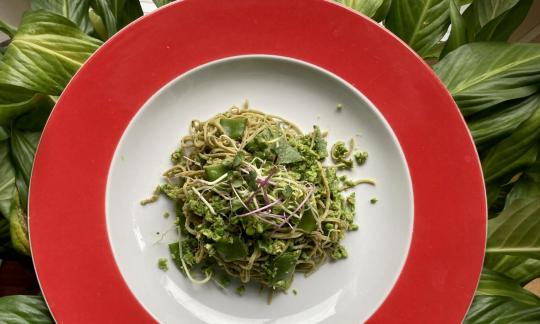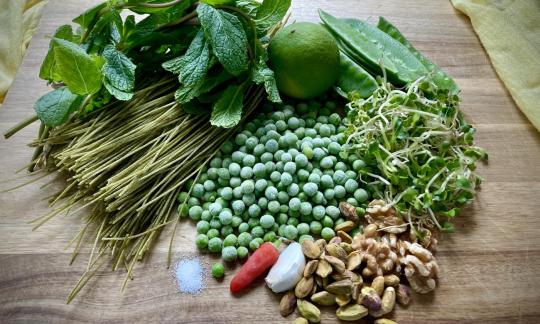Soba noodles with peas, pistachios, sprouts and mint
vegan
Ingredients (for servings, )
Equipment
- stove
- citrus juicer (lemon squeezer)
- saucepan
- sieve
- shredder
Type of preparation
- cook
- chop or grind
- sauté
- squeeze
- season to taste
- remove the skin
- drain
Preparation
Preparing vegetables
Let the peas thaw. Wash the mint and pick off the leaves. Peel the garlic. Put the pistachios, walnuts, chili, garlic and mint in a food processor and chop. Squeeze the lime and add it together with the peas and salt and mix again briefly so that the ingredients are chopped but not pureed. Clean the sugar snap peas, remove the ends, cut the pods into strips and set aside for step 3. Clean the watercress and set aside.If you don't have watercress on hand, you can also use radish, broccoli sprouts or garden cress.
The quantity of mint refers to the leaves including the stems. For the amount of 4 portions, we used a small bunch of mint. Instead of Moroccan mint, you can use green mint. Peppermint contains significantly more menthol, which would be too strong.
Preparing soba noodles
Boil water in a pot. Add the pasta and stir. Cook for about 5 minutes according to the instructions on the packet and then drain. Add a little rapeseed oil to the pasta and stir well so that it doesn't stick.Meanwhile, proceed to the next step.
Reduce salt content: The high salt content is due to the fact that we have based our recipe on conventional commercial soba noodle varieties from Europe, which contain up to 1 g of table salt per 100 g (in the USA even over 2.0). However, there are low-salt soba noodle variants (0.01 g per 100 g). We therefore always recommend using low-salt soba noodles. If you do not have soba noodles to hand, you can also use whole wheat noodles and, as a gluten-free variant, Use whole grain rice noodles or edamame noodles (see recipe picture).
Put the sugar snap peas in a pan with a little water and let them simmer over a low heat for about 5 minutes. Remove the pan from the heat, pour off any water and mix with the pea mixture.
Completing the recipe
Put the noodles in a bowl and mix with the pea and sugar snap pea mixture. Add a little water if necessary and heat a little more if necessary. Season with salt and pepper and arrange on plates. Serve with the sprouts as a topping. You can enjoy the dish both warm and cold.
|
Nutritional Information per person
Convert per 100g
|
2000 kcal | |
|---|---|---|
| Energy | 412 kcal | 20.6% |
| Fat/Lipids | 14 g | 20.3% |
| Saturated Fats | 1.5 g | 7.6% |
| Carbohydrates (inc.dietary fiber) | 60 g | 22.4% |
| Sugars | 7.9 g | 8.8% |
| Fiber | 8.0 g | 31.8% |
| Protein/Albumin | 17 g | 34.9% |
| Cooking Salt (Na:243.8 mg) | 619 mg | 25.8% |
| Essential micronutrients with the highest proportions | per person | 2000 kcal | |
|---|---|---|---|
| Vit | Vitamin K | 73 µg | 97.0% |
| Prot | Tryptophan (Trp, W) | 0.20 g | 80.0% |
| Min | Manganese, Mn | 1.6 mg | 78.0% |
| Vit | Vitamin C (ascorbic acid) | 60 mg | 74.0% |
| Prot | Threonine (Thr, T, irreversibly transaminated) | 0.63 g | 67.0% |
| Vit | Vitamin B1 (Thiamine) | 0.68 mg | 61.0% |
| Vit | Vitamin B9, B11 (Folate, as the active form of folic acid) | 119 µg | 60.0% |
| Prot | Valin (Val, V) | 0.93 g | 58.0% |
| Min | Copper, Cu | 0.56 mg | 57.0% |
| Prot | Isoleucine (Ile, I) | 0.70 g | 57.0% |
Detailed Nutritional Information per Person for this Recipe
The majority of the nutritional information comes from the USDA (US Department of Agriculture). This means that the information for natural products is often incomplete or only given within broader categories, whereas in most cases products made from these have more complete information displayed.
If we take flaxseed, for example, the important essential amino acid ALA (omega-3) is only included in an overarching category whereas for flaxseed oil ALA is listed specifically. In time, we will be able to change this, but it will require a lot of work. An “i” appears behind ingredients that have been adjusted and an explanation appears when you hover over this symbol.
For Erb Muesli, the original calculations resulted in 48 % of the daily requirement of ALA — but with the correction, we see that the muesli actually covers >100 % of the necessary recommendation for the omega-3 fatty acid ALA. Our goal is to eventually be able to compare the nutritional value of our recipes with those that are used in conventional western lifestyles.
| Essential fatty acids | per person | 2000 kcal |
|---|---|---|
| Linoleic acid; LA; 18:2 omega-6 | 5.0 g | 50.0% |
| Alpha-Linolenic acid; ALA; 18:3 omega-3 | 0.98 g | 49.0% |
| Essential amino acids | per person | 2000 kcal |
|---|---|---|
| Tryptophan (Trp, W) | 0.20 g | 80.0% |
| Threonine (Thr, T, irreversibly transaminated) | 0.63 g | 67.0% |
| Valin (Val, V) | 0.93 g | 58.0% |
| Isoleucine (Ile, I) | 0.70 g | 57.0% |
| Leucine (Leu, L) | 1.2 g | 49.0% |
| Phenylalanine (Phe, F) | 0.74 g | 48.0% |
| Lysine (Lys, K, irreversibly transaminated) | 0.88 g | 47.0% |
| Methionine (Met, M) | 0.24 g | 26.0% |
| Vitamins | per person | 2000 kcal |
|---|---|---|
| Vitamin K | 73 µg | 97.0% |
| Vitamin C (ascorbic acid) | 60 mg | 74.0% |
| Vitamin B1 (Thiamine) | 0.68 mg | 61.0% |
| Vitamin B9, B11 (Folate, as the active form of folic acid) | 119 µg | 60.0% |
| Vitamin B6 (pyridoxine) | 0.50 mg | 36.0% |
| Vitamin B5 (Pantothenic acid) | 1.5 mg | 26.0% |
| Vitamin B3 (Niacin) | 3.8 mg | 24.0% |
| Vitamin A, as RAE | 173 µg | 22.0% |
| Vitamin B2 (Riboflavin) | 0.26 mg | 19.0% |
| Vitamin B7 (Biotin, ex vitamin H) | 9.1 µg | 18.0% |
| Vitamin E, as a-TEs | 1.3 mg | 11.0% |
| Essential macroelements (macronutrients) | per person | 2000 kcal |
|---|---|---|
| Phosphorus, P | 323 mg | 46.0% |
| Potassium, K | 610 mg | 31.0% |
| Magnesium, Mg | 114 mg | 30.0% |
| Sodium, Na | 244 mg | 30.0% |
| Calcium, Ca | 114 mg | 14.0% |
| Essential trace elements (micronutrients) | per person | 2000 kcal |
|---|---|---|
| Manganese, Mn | 1.6 mg | 78.0% |
| Copper, Cu | 0.56 mg | 57.0% |
| Iron, Fe | 5.3 mg | 38.0% |
| Zinc, Zn | 2.3 mg | 23.0% |
| Selenium, Se | 4.0 µg | 7.0% |
| Iod, I (Jod, J) | 4.4 µg | 3.0% |
| Fluorine, F | 0.75 µg | < 0.1% |
In the soba noodles with peas, pistachios, sprouts and mint, half of the ingredients remain raw, which benefits the ingredients.
Nutrient profile: According to GDA guidelines, one portion of this dish covers 100% of the daily requirement of vitamin K. In addition to many essential amino acids, vitamin C and folic acid are also covered by more than 60%. The ratio of omega-6 to omega-3 fatty acids is 5:1, which is within the maximum recommended ratio.
You can find further information on this topic at the following link: Vegans often eat unhealthily. Avoidable nutritional errors.
Soba noodles: Soba noodles, an essential part of Japanese cuisine, are thin, brown-grey noodles made from buckwheat. The noodles are known for their good flavor absorption. They are available in different qualities and with different salt contents (see tips), although some variants contain wheat flour and therefore gluten.
Peas: Green peas have a crunchy consistency and can be used in many different dishes. They can be eaten raw and are high in protein and carbohydrates.
Sugar snap peas (sweet peas): Sugar snap peas are a type of pea from the legume family. The tender sugar snap peas are usually eaten with their pods. They taste similar to peas, but are a little sweeter and juicier. They can also be eaten raw in salads, as they do not contain phasin, which causes damage to blood cells and the intestinal wall in large quantities. Some pods have threads that must be removed before use.
Mint: Moroccan mint is a derivative of spearmint. It has a milder taste than peppermint and is particularly suitable for food. Moroccan mint has a slightly peppery taste and a minty, fresh, sweet scent. It contains little menthol compared to most other mints, but provides a very good mint aroma (one reason why we chose this type of mint).
Walnut: The real walnut, also called tree nut, has the highest content of alpha-linolenic acid (an omega-3 fatty acid that is healthy for the heart) of all nuts. They are also rich in vitamin E, zinc (an important trace element for the liver and hair, among other things) and potassium (for the heart muscle, among other things).
Watercress: The fresh and cress-like, sharp taste of watercress ( Nasturtium officinale) is caused by the mustard oil glycoside gluconasturtiin. In comparison to the widely used garden cress ( Lepidium sativum), watercress is rarely found in stores. The mustard oil glycosides it contains are responsible for the characteristic sharp watercress taste.
Reduce salt content: The high salt content is due to the fact that we have based our product on conventional commercial soba noodle varieties from Europe, which contain up to 1 g of table salt per 100 g (in the USA even up to over 2.0). However, there are low-salt soba noodle varieties (0.01 g per 100 g). We therefore always recommend using low-salt soba noodles.
Pistachios: Pistachios have a very special aroma that is even more intense when dry roasted. Without additional salt, the stone fruit of the pistachio tree ( Pistacia vera) is definitely healthier than the salted variety. Due to the poor ratio between omega-6 and omega-3 (52:1), we do not use pistachios alone, but in combination with walnuts.
Soba noodle substitute: If you don’t have soba noodles on hand, you can also use whole wheat noodles and as a gluten-free option Use whole grain rice noodles or edamame noodles (see recipe picture).
Mint: Instead of Moroccan mint, you can use green mint. Peppermint contains significantly more menthol, which would be too strong.
Alternative to watercress: Instead of the hard-to-find watercress, you can also use radish, broccoli sprouts or garden cress.






